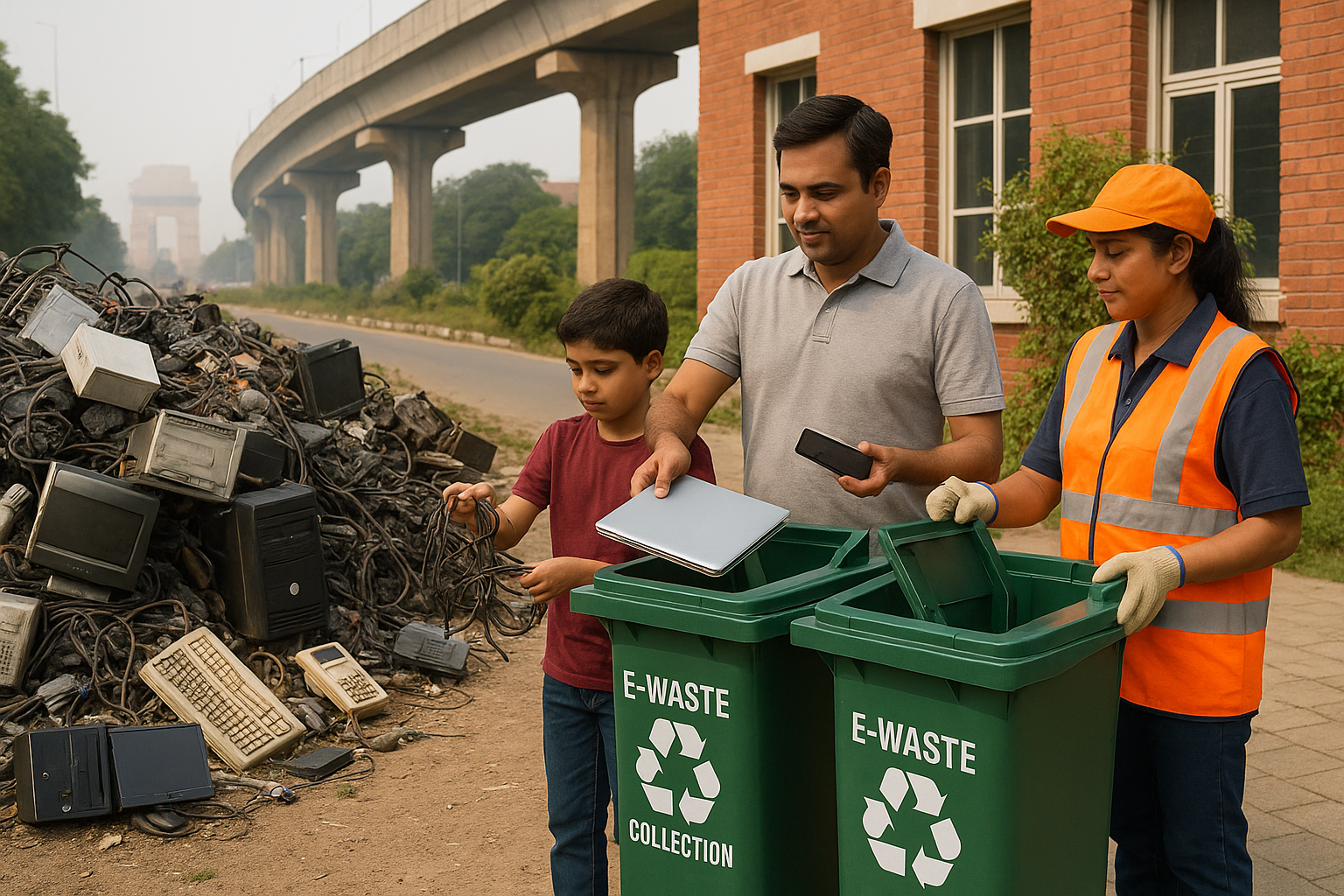A focused citywide campaign is underway in Delhi to combat the unchecked rise of electronic waste — a silent, toxic pollutant infiltrating the capital’s air, water, and soil. Spearheaded by the Delhi government, the initiative aims to build a structured and citizen-driven approach to responsible e-waste management through public awareness, policy coordination, and accessible recycling infrastructure.
The campaign arrives at a critical moment. As households and businesses rapidly upgrade their devices and digital infrastructure, the volume of discarded electronics — from smartphones and modems to batteries and circuit boards — is growing far beyond what informal recycling systems can safely handle.
E-Waste: The Unseen Pollutant
Delhi’s e-waste problem has remained largely invisible to the public eye. While air pollution and plastic waste dominate headlines, the threat from discarded electronics has steadily expanded in the background. Improperly dismantled e-waste releases heavy metals like mercury, lead, and cadmium, which leach into soil and groundwater or get released into the air during open burning.
These processes happen largely in unregulated scrap clusters across the city — often in residential areas where children and informal workers handle toxic components without protective gear. The result is a slow, cumulative health hazard that affects lungs, skin, immune systems, and even neurological development.
This campaign is the first concerted attempt by the city to acknowledge and systematically address the dangers at both the environmental and human level.
What the Campaign Is Doing Differently
Unlike past efforts that remained limited to occasional clean-up drives, Delhi’s new e-waste initiative takes a layered, long-term approach. It’s designed to create behavior change through education while also enabling structural change through access.
Awareness Outreach in Schools, Homes, and Markets
The first leg of the program involves targeted outreach in schools, housing societies, markets, government offices, and tech parks. The goal is to demystify e-waste: what it is, why it’s dangerous, and how individuals can dispose of it safely.
Workshops and local awareness events will equip citizens with the knowledge needed to shift from casual disposal to conscious recycling. This is especially crucial in middle-class and affluent neighborhoods where device replacement is frequent, but awareness of safe disposal is minimal.
Building an Authorized Collection Ecosystem
A key aspect of the plan is the rollout of authorized collection channels. Bins and kiosks will be placed in public and semi-public areas where people can safely drop off e-waste, ensuring it reaches certified recyclers. Mobile collection units are also being proposed for dense or underserved neighborhoods.
This infrastructure is being developed in partnership with authorized recyclers, ensuring that materials are not only removed from circulation but also processed under pollution-control norms.
Multi-Agency Coordination
The Delhi Pollution Control Committee (DPCC), municipal corporations, and various civic bodies are coordinating on execution, ensuring that waste logistics, urban planning, and public health mandates are aligned. The involvement of private sector recyclers, NGOs, and community organizations adds further depth to the effort, enabling localized solutions.
Why Public Participation Is Crucial
The success of this initiative hinges not on legislation alone, but on whether everyday citizens participate. E-waste is not easily visible or regulated like plastic bags or industrial emissions. It often sits quietly in drawers or storerooms — old chargers, unused laptops, broken remotes — waiting to be dumped with household trash.
Unless individuals change their disposal habits, even the best infrastructure will fall short. That’s why this campaign has focused so heavily on awareness and accessibility.
Behavioral change is often slow, but Delhi’s push appears to be grounded in practical, relatable messaging. Rather than overwhelming citizens with abstract statistics, the campaign draws attention to daily habits and small decisions that can either protect or pollute the city.
Environmental and Public Health Stakes
E-waste, when mismanaged, doesn’t just contaminate soil or water in isolation. It creates long-term exposure zones, where toxic metals accumulate and gradually enter the food chain. Lead and mercury poisoning, once rare, are increasingly being observed in children living near informal recycling sites.
In this context, Delhi’s campaign is not just about waste — it’s about public health, children’s safety, and sustainable urban living.
By addressing the root causes — lack of awareness, missing infrastructure, and informal handling — the city is attempting to shift from reactive to preventive environmental policy.
A Step Toward Circular Urban Management
The campaign also aligns with broader efforts to build a circular economy in Indian cities — where resource recovery and safe recycling become integral to waste management. It represents a shift from landfill dependence to intelligent material flow.
Long-term, this campaign could lay the foundation for more advanced interventions, including:
- A centralized e-waste eco park
- Digital tracking of electronic disposal patterns
- EPR (Extended Producer Responsibility) enforcement for manufacturers
For now, the focus remains on enabling every citizen to become part of the solution.
FAQs on Delhi’s E-Waste Management Campaign
What is e-waste, and why is it harmful?
E-waste (electronic waste) includes discarded devices like old computers, phones, batteries, and chargers. When not handled properly, it releases harmful substances such as lead, mercury, and cadmium. These toxins contaminate air, soil, and water and can cause serious health problems, especially in children.
How much e-waste does Delhi produce?
Delhi is one of India’s largest generators of e-waste, contributing significantly to the country’s annual output of over 1.5 million tonnes. This is driven by rapid digital consumption across homes, offices, and institutions.
How is the Delhi government addressing e-waste?
The campaign focuses on public awareness, safe disposal, and creating infrastructure. It includes outreach in schools and markets, authorized collection bins, mobile pickup units, and coordination between civic agencies and recyclers.
Where can I safely dispose of my e-waste in Delhi?
You’ll soon find e-waste drop-off bins in housing societies, offices, and public areas. Mobile collection vans will cover high-density zones. You can also contact your local RWA or municipal office for nearby authorized disposal points.
Can I give old electronics to scrap dealers?
No. Informal scrap dealers often use unsafe methods like open burning or acid to extract metals. This is hazardous to workers and pollutes the environment. Always use certified recyclers or official collection points.
What items are considered e-waste?
E-waste includes mobile phones, tablets, laptops, TVs, batteries, cables, printers, keyboards, chargers, electronic toys, remotes, and smart home devices.
Is there any law governing e-waste in India?
Yes. The E-Waste Management Rules (2022) require producers and users to dispose of electronics responsibly. Delhi’s campaign is helping implement these rules locally by building awareness and collection systems.
What can schools and RWAs do to support the campaign?
They can host awareness workshops, set up temporary collection drives, and partner with the government to install collection bins. Students and residents are encouraged to participate in sorting and safe disposal at the community level.
Are there any incentives for recycling e-waste?
At this stage, the focus is on access and education. However, the government is exploring partnerships that could offer future incentives like exchange discounts or rewards through authorized recyclers.

